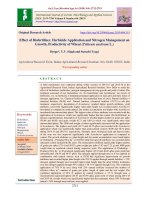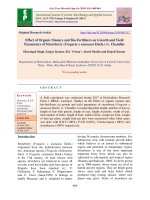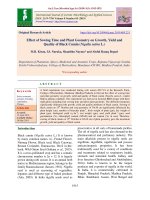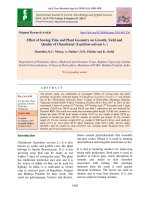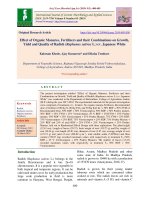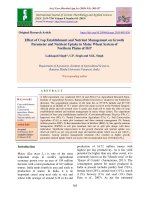Interactive effect of salt and drought stresses on growth of sugar cane plants under greenhouse conditions
Bạn đang xem bản rút gọn của tài liệu. Xem và tải ngay bản đầy đủ của tài liệu tại đây (16.36 MB, 83 trang )
VIETNAM NATIONAL UNIVERSITY OF AGRICULTURE
FACULTY OF AGRONOMY
UNDERGRADUATE THESIS
TITLE:
EFFECT OF SALT STRESS AND DROUGHT STRESS
ON GROWTH OF SUGAR CANE PLANTS UNDER
GREENHOUSE CONDITIONS
Supervisor:
Ph.D LE THI TUYET CHAM
Department:
Plant Genetics and breeding
Student:
VU KHANH LINH
Class:
K61 - KHCTT
Course:
2016 – 2021
Major:
CROP SCIENCE
Ha Noi - 2020
i
DECLARATION
I hereby declare that this paper is my own work. All results and data in
this thesis are absolutely honest and have not been used in a different thesis. All
sources used in this paper were cited in references.
Hanoi, January 25th ,2021
Student
Vu Khanh Linh
ii
ACKNOWLEDGEMENTS
To complete this thesis, I am deeply indebted to people who have been
providing me with precious support and advice.
Firstly, I would like to send my gratitude to my supervisor, Ph.D. Le Thi
Tuyet Cham, Department of Genetics and Plant Breeding, Faculty of Agronomy,
Vietnam National University of Agriculture, for their enthusiastic support,
helpful advice and considerable encouragement in the completion of my thesis.
I would also like to express sincere thanks to Ph.D. Vu Ngoc Thang from
Industrial and Medicinal Plants and all the lectures from Faculty of Agronomy,
who taught and created best conditions for students during learning process and
research.
Last but not the least, I would like to thank my family and my friends who
have alwaay beens by my side, give me support and strength to complete this
graduattion thesis.
Hanoi, January 25th , 2021
Student
Vu Khanh Linh
iii
CONTENT
Contents
CHAPTER 1. INTRODUCTION............................................................................................................................. 1
1.1.Introduction...................................................................................................................................................1
1.2. Objectives and requirements...................................................................................................................... 2
1.2.1. Objectives...............................................................................................................................................2
1.2.2. Requirements.........................................................................................................................................2
CHAPTER 2. LITERATURE REVIEW.................................................................................................................. 3
2.1. Origin, classification and distribution of sugarcane................................................................................. 3
2.1.1. Origin of sugarcane...............................................................................................................................3
2.1.2. Classification of sugarcane...................................................................................................................4
2.1.3. Nutritional values of sugarcane........................................................................................................... 4
2.2. Situation of Sugarcane production on the world and in Vietnam...........................................................5
2.2.1. Situation of Sugarcane production in the world................................................................................ 5
2.2.2 Situation of Sugarcane production in Vietnam...................................................................................8
2.2.3. Some research results on drought tolerance on some crops in the world and Vietnam...............12
2.2.4. Some research results on drought tolerance of sugarcane in the world and Vietnam................. 16
2.2.5. Some research results on salt tolerance on some crops in the world and Vietnam...................... 19
2.2.6. Some research results on salt tolerance on Sugarcane in the world and Vietnam....................... 22
CHAPTER 3. MATERIAL AND METHOD..................................................................................................... 24
3.1. Object.......................................................................................................................................................... 24
Figure 1: Sugarcane seedlings before transplanting to pots................................................................................ 24
3.2. Materials.......................................................................................................................................................25
3.3. Location and time.......................................................................................................................................25
3.3. Experimental design.................................................................................................................................. 26
3.4. Methods.......................................................................................................................................................26
CHAPTER 4. RESULT AND DISCUSSION..................................................................................................... 29
4.1. The effect of salinity stress and drought stress on growth and development of sugarcane................ 29
4.1.1. The effect of salinity stress and drought stress on plant height of sugarcane...................................... 29
4.1.2.The effect of salinity stress and drought stress on the plant diameter of sugarcane............................. 32
4.1.3. The effects of salinity stress and drought stress on the number of leaves of Sugarcane...................... 34
4.1.4. The effect of salinity stress and drought stress on leaf length growth of sugarcane............................ 35
4.1.5. The effect of salinity stress and drought stress on leaf width growth of sugarcane............................. 37
4.1.6. Effect of Salinity stress- drought stress on root length......................................................................... 38
4.1.7. Effect of salinity stress and drought stress to leaf area........................................................................ 40
4.2. The effect of salinity stress and drought stress on physiology of sugarcane........................................ 41
4.2.1. Effect of salinity stress and drought stress on SPAD index of sugarcane......................................41
iv
4.2.2. The effect of salinity and drought stress to chlorophyll fluorescence performance indices (Fv/Fm)
.........................................................................................................................................................................43
4.2.3. The effect of salinity stress - drought stress to water saturation deficit (WSD)................................... 45
4.2.4. Evaluate of significant differences in the fresh and dry weight of roots between each treatment........46
4.2.5. Evaluate of significant differences in the fresh and dry weight of stem between each treatment........ 50
CHAPTER 5: CONCLUSIONS AND SUGGESTIONS................................................................................... 53
5.1. Conclusion...................................................................................................................................................53
5.2. Suggestions..................................................................................................................................................53
REFERENCES......................................................................................................................................................55
Vietnamese references:..................................................................................................................................... 55
Foreign references:........................................................................................................................................... 55
APPENDIX.............................................................................................................................................................63
Some pictures in the experiment course......................................................................................................... 63
v
LIST OS TABLES
vi
LIST OF FIGURES AND CHARTS
vii
LIST OF ABBREVIATIONS
ABBREVIATION
MEANING
%
Percentage
CV
Coefficient of variation
DM
Dry mass
DW
Dry weight
Et al.
et alii
FAO
FM
Food and Agriculture Organization
The Food and Agriculture Organization
Corporate Statistical Database
Fresh mass
FW
Fresh weight
TW
Turgid weight
LA
Leaf area
WSD
Water saturation deficit
LSD
Least significant difference
SPAD
Soil Plant Analysis Development
AS
After salinity stress
AD
After drought stress
WB
Watering back
T1
Without salinity - without drought
T2
Without salinity - Drought
T3
Salinity - without drought
T4
Salinity - Drought
FAOSTAT
viii
CHAPTER 1. INTRODUCTION
1.1.Introduction
Sugarcane (Saccharum officinarum), perennial grass of the family
Poaceae is a major sugar producing crop in the tropical and subtropical
regions (Cordeiro et al.2007). The plants are two to six meters (six to
twenty feet) tall with stout, jointed, fibrous stalks. Sucrose, was
accumulated in the stalk internodes. Sugarcane is the world's largest crop
by production quantity, with 1.8 billion tonnes produced in 2017, with
Brazil accounting for 40% of the world total. In 2012, the Food and
Agriculture Organization estimated it was cultivated on about 26 million
hectares (64 million acres), in more than 90 countries. In Vietnam,
sugarcane is also a highly economical tree and is grown in many regions
such as Thanh Hoa, Nghe An and some provinces in the North and Tay
Nguyen. In particular, Vietnam is assessed to have many favorable
conditions to increase the productivity and output of sugarcane, thereby
meeting the large sugar processing demand for domestic and export
purposes, bringing a significant source of foreign currency. (Trinh Minh
Chau, 2003). Currently, sugarcane is considered as an important crop
actively participating in the work of transforming the crop structure,
increasing
economic
efficiency
and
improving
the
ecological
environment.
Drought is one of the most important abiotic factors affecting plant
growth, development and production on a global scale (Boyer, 1982).
Drought reduces productivity, output and affects the economy of many
countries. Faced with increasing droughts besides the development of
irrigation systems, zoning for irrigation water management, the use of
cultivars that are able to adapt well to drought is essential. Therefore,
1
drought is one of the factors that clearly affect the productivity and yield
of sugarcane in sugarcane growing regions in the world in general and
Vietnam in particular. Meanwhile, there are not many specific researches
on the effects of artificial drought conditions on the growth and
development of some popular sugarcane varieties grown in production.
Salinity is another one vital limiting factor for sus-tainable agriculture
with depressing crop growth and production worldwide (Zinselmeier C,
2009). Globally,more than 70 countries have been characterized as
existing large areas of salinity-affected land sand over 6% of the world’s
total land is affected by salinity stress (AminiS 2017). Salinity stress
could not only reduce crop yield through affecting leaf physiological
growth (Starvridou, 2015), but also could reduce the ability of plant roots
to take up water and nutrition (e.g.,N) from soil (Munns R, 2017). While
other studies showed that salinity could increase transgenic barley growth
and yield in both glass house and field conditions, but the mechanisms
were un- clear (Schilling R, 2014).
Following the fact mentioned above, we do a research on: “Interactive
effect of salt and drought stresses on growth of sugarcane plants under
glasshouse conditions ”
1.2. Objectives and requirements
1.2.1. Objectives
Evaluating the effect of salt stress and drought stress on growth of
sugarcane plants
1.2.2. Requirements
- Evaluating the effect of salt stress and drought tolerant to growth
characteristics in sugarcane plants
- Evaluating the effect of salt stress and drought tolerant to physiological
characteristics in sugarcane plants
2
CHAPTER 2. LITERATURE REVIEW
2.1. Origin, classification and distribution of sugarcane
2.1.1. Origin of sugarcane
Sugarcane is a grass plant of the genus Saccharum, tribe Andropogoneae
that can be found in 36 species . It was originally native to warm tropical
regions of Asia, but after early civilizations found out about its usefulness
it quickly spread. This enabled new civilizations to improve theirsugar
production with crossbreeding (all current commercial sugarcane are
complex hybrids), which only increased sugarcane’s popularity.
Sugarcane was originally domesticated around 8000 BC in New Guinea.
From there knowledge about this plant slowly moved toward east across
Southeast Asia until it reached India, where the first organized production
of sugar began during middle of 1st millennia BC. In the beginning sugar
was extracted from sugarcanes by chewing and extracting fluids via water,
but in 5th century Indian chemist found a way to crystalize extracted
sucrose, making sugar much easier to transport. With this great discovery,
sugar became very expensive trading item of India, and sugarcane
themselves started spreading across the Asia and Middle East. Arab
nations adopted sugarcane, and spread them toward Mediterranean,
especially after they managed to conquer Egypt. From there sugarcane
reached Spain around 715 AD, but they did not took hold until Crusades,
when majority of the Europe became acquainted with the sugar that was
imported from the Middle East. Spain, Portugal, Italy, Cypress and
Azores tried to establish stable economy around sugarcane in 16th and
17th century, but vast new lands in the New World offered better climate.
Because of that, sugarcane were quickly introduced to the Americas,
3
where landowners created vast plant ages of this plant. Because growing
and processing of sugarcane was not easy, and demand for sugar was
extremely high, organized culling of Africa for slaves became very
profitable and popular. With over 12 million slaves displaced from Africa,
production of sugar skyrocketed, managing to drop in price and become
available to everyone during 19th century.
Today, sugarcane is the world largest crop. In 2010 it was estimated that
over 23.8 million hectares of sugarcanes were cultivated in over 90
countries around the world, with a worldwide harvest of 1.69 billion
tonnes. The largest producer of Sugarcanes is Brazil, and behind him are
India, China, Pakistan, Thailand and Mexico. Also, sugarcane represents
a source for 75-80% of worldwide sugar production, with the majority of
the rest being taken by sugar beet that is more suited to grow in Europe.
2.1.2. Classification of sugarcane
Sugarcane or sugar cane refer to several species and hybrids of tall
perennial grass in the family Poaceae, the class Liliopsida, the order
Poales and the genus Saccharum L. The scientific name of sugarcane is
Saccharum officinarum.
2.1.3. Nutritional values of sugarcane
Sugarcane is loaded with antioxidants that help to counteract infections
and enhance immunity. It has high content of calcium, magnesium, iron
and other electrolytes which is great for dehydration. It is a cure for
common cold as well as other infections and also counteracts fever as it
enhances the level of body’s protein. An intake of raw sugarcane juice
provides various health benefits and is also packed with vital nutrients
which are essential for the body. Sugarcane is a base ingredient for
molasses, jaggery, rum, ethanol and biofuel. Sugarcane contains high
content of Vitamin B2, Vitamin B1, Vitamin C, Vitamin B6 and
4
inorganic salts such as iron, phosphorus, calcium and organic acids such
as fumaric acid, succinic acid, citric acid and malic acid.
2.2. Situation of Sugarcane production on the world and in Vietnam
2.2.1. Situation of Sugarcane production in the world
Sugarcane is the main raw material source of the sugar processing
industry. Sugarcane currently accounts for over 60% of the world's total
crude sugar production. Sugarcane is a plant that has many nutrients such
as protein, calcium, minerals, iron, most of which are sugar, helping
people to heat up, refresh their thirst, relieve fatigue, help digestion and
provide energy for muscles. moving. Sugar plays a very important role in
the daily diet of people, is an indispensable need in social life. Sugarcane
is a multi-purpose plant, in addition to its main product being sugar,
sugarcane is also raw materials, either directly or indirectly, of many
industries such as wine, paper, plywood, pharmaceuticals, electricity from
bagasse; animal feed, fertilizers from leaves, sugar cane tops, filtered
sludge and kiln ash; Molasses is used as an industrial raw material to
produce biofuel, alcohol, acetone solvents, butanol, yeast, citric acid,
lactic, aconitic and glycerin, ... Sugarcane by-products if exploited
thoroughly, the value can also be 3-4 times higher than genuine (sugar).
Sugarcane is a tree that has the ability to stump for many years, that is,
one planting can yield many crops. After each harvest, the sugarcane field
is treated and cared for, the original germs continue to regenerate and
develop. The yield of sugarcane in the first base crop is sometimes higher
than that of the silk cane crop. Sugarcane fields to have many original
crops, the higher the economic value (reducing production costs). Thanks
to the feature of having a large leaf area index (5-7 times more than the
land area) and high ability to take advantage of sunlight (up to 6-7%
while other crops only reach 1 - 2%), within 10 - 12 months, one hectare
of sugarcane can yield hundreds of tons of sugarcane trees and a large
amount of green leaves, roots and roots left in the soil. Sugar cane can be
grown in many different ecological regions (climate, soil, drought or
inundation, ...), well resilient to the harsh conditions of nature and the
environment, easy to adapt to production levels from primitive to modern.
The world sugar industry has developed strongly since the 16th century.
Global sugar production has grown rapidly according to consumption
demand. In the early years of the industrial revolution (1750-1830), only
820,000 tons / year and before that. The first war (1914-1918) was about
18 million tons / year, so far it has reached
over 170 million tons / year.
5
According to FAOSTAT, by the end of the year 2018, sugarcane has
been cultivated in 104 different countries including countries with large
area: Brazil, India, China, Australia, Mexico, Indonesia and United
States… Actually, Brazil appeared to be a country having by far the
largest area of sugarcane (10 million ha) which was followed by India
with about 4.7 million ha and China with about 1.4 million ha. Brazil also
ranked the first world for production of sugarcane with approximately
746.8 million-ton, accounting for about 39.16% (746.8/1907) of the total
production in the world (FAOSTAT, 2018).
Table 2.1: World sugarcane production in recent years
Harvested area
Yield
Production
(million ha)
(ton/ha)
(million ton)
2010
23.69
78.31
1682.84
2011
25.53
77.48
1794.12
2012
26.01
77.60
1831.01
2013
26.86
78.06
1901.87
2014
27.10
76.72
1885.96
2015
26.62
77.65
1875.06
2016
26.60
77.69
1874.61
2017
26.13
78.10
1851.33
2018
26.27
80.02
1907.02
Years
Source: FAOSTAT, 2020
The Table 2.1 showed that harvested area, production and yield of
sugarcane in the world have changed significantly. A dramatic in the
number of harvested area of sugarcan was recorded during the years 2010
– 2018, from about 23.69 million ha to roughly 26.27 million ha. Actually,
the number of sugarcane yield increased dramatically, from about 78.31
ton/ha in 2010 to 78.06 ton/ha in 2013 but later declined suddenly to
about 77.69 ton/ha in 2016. From 2018, it skyrocketed, up to 80.02 ton/ha.
The production of sugarcane reached to be the highest, with 1907.02
million ton in 2018. In 2014, the harvested area was found to be by far
the largest one (27.10 million ha).
6
Table 2.2. Sugarcane production in major continents in recent years
Continents
Harvested area
Yield
Production
(million ha)
(tons/ha)
(million tons)
2017
2018
2017
2018
2017
2018
Asia
10.124
10.280
75.706
80.628
695.317
751.902
Europe
0.0379
0.0378
83.483
66.600
2.867
2.280
Americas
13.964
13.920
80.711
80.994
Africa
1.506
1.548
67.663
67.612
92.425
94.925
Oceania
0.497
0.485
84.909
79.867
38.277
35.131
1022.448 1022.786
Source: FAOSTAT, 2020
7
The table 2.2 indicated that there is a dramatic shift in the production of
sugarcane in mega continents from 2017 to 2018. In the 2 years, the
sugarcane production of Asia, America, Africa has increase tendency
recorded at about 56.000 million tons (in Asia) ,338 million tons (in
Americas), 500 million tons (in Africa); constrastly that of Europe &
Oceania decreased nearly 400 million tons (in Europe), over 3.000 (in
Oceania). Americas has the largest harvested area of sugarcane
with
13.920 million ha in 2018; although the harvested area declined 44
million ha compared with 2017, the sugarcane yield and production still
get a surprisingly higher number, particularly increasing from 80.711 to
80.994 tons/ha with the yield and from 1022.448 to 1022.786 million tons
with the production.
At the second position of sugarcane harvested area, from 2017 to 2018,
Asia seem to take much effort, the result that the harvested area, yield and
production still raised up, specially the sugarcane yield of Asia in 2018
with 80.628 tons/ha was nearly as high as that of Americas with 80.994
tons/ha.
Oceania & Europe are two continents with the smallest harvested area,
there is a remarkable decrease in both sugarcane harvested area, yield &
production in the 2 continents; the harvested area slightly decreased only
under 0.01 million ha, but the yield strongly got down from 5.000 to
15.000 tons/ha.
2.2.2 Situation of Sugarcane production in Vietnam
Sugar cane and the profession of making molasses and sugar in Vietnam
have existed since ancient times, but the sugar industry has only been
developed since the 1990s. Until 1994, the country had only 9 sugar cane
factories with total capacity. less than 11,000 tons of sugarcane / day and
2 refineries with small capacity and outdated equipment, leading to the
8
need to import an average of 300,000 to 500,000 tons of sugar each year.
Realizing the huge wastes in processing and domestic production of sugar,
the sugar program has been launched since 1995. This program has been
selected as the starting program for industrialization and modernization.
rural agriculture, hunger eradication, poverty alleviation, job creation for
agricultural workers. In Vietnam, sugar cane is an important sugar plant,
grown in almost all ecological regions of the country. However,
concentrated mainly in the North Central Coast (Nghe An, Thanh Hoa),
the Northern provinces (Hoa Binh, Son La ...), the provinces of the South
Central Coast, the Central Highlands.
In Vietnam, sugarcane has not been paid much attention and attention,
the area has not grown too large. In general, the area of
sugarcane
increased slightly and decreased slightly in the period from 2004 to 2016,
the cultivated area reached the largest in 2014 with 0.3 (million ha).
Productivity in general tends to increase and increase sharply from 2010
to 2014. Compared with the world average yield, Vietnam's sugarcane
productivity is lower, the annual output increases but is not stable during
the period 2004 - 2016, sometimes the output reached 17.3 (million tons)
in 2007, some years reached 15.6 (million tons) in 2009.
Table 2.4. Sugarcane acreage, productivity and production in
Vietnam in the period 2004 - 2016
Year
Acreage
Quantity
Productivity
(million ha)
( million tons)
(tons / ha)
2004
0,2
15,6
54,6
2005
0,2
14,9
56,1
2006
0,2
16,7
58,0
2007
0,2
17,3
59,2
2008
0,2
16,1
59,6
9
2009
0,2
15,6
58,7
2010
0,2
16,1
60,0
2011
0,2
17,5
62,1
2012
0,3
19,0
63,0
2013
0,3
20,1
64,8
2014
0,3
19,8
65,0
2016
0,2
18,3
64,4
Source: Food and Agriculture Organization of the United Nations (FAO,
2016).
In recent years, due to the phenomenon of climate change, most of the
sugarcane growing areas in our country are facing difficulties. In which,
drought, inundation and rising temperature are considered the main
reasons for the serious drop in sugarcane productivity and production.
There are places where sugarcane has low productivity, is grown
ineffectively or is lost. In addition, the sugarcane area is also narrowed
due to external factors such as pests, diseases, farming techniques ...
According to the General Statistics Office of Vietnam, sugarcane acreage
and production are the largest in Thanh Hoa and Gia Lai provinces (Table
4). In general, the acreage and output of the provinces across the country
tend to increase, the sugarcane acreage is increasingly being expanded to
other provinces.
Table 2.5. Sugarcane acreage and yield in some provinces in the
country in 2014 - 2015
Acreage (thousand
Province
Quantity (thousand tons)
hectares)
2014
2015
2014
2015
Nghe An
28,40
26,70
1.634,30
1.560,10
Thanh Hoa
30,40
32,20
2.005,80
1.863,80
10
Son La
5,20
5,50
350,50
352,30
Hoa Binh
9,30
9,50
633,20
645,90
Lam Dong
0,60
0,40
39,40
28,10
Ha Giang
0,60
0,60
15,70
15,60
Tuyen Quang
10,70
11,60
638,90
690,70
Gia Lai
38,20
38,60
2.186,30
2.304,70
Source: General Statistics Office of Vietnam 2016
Cultivation technique is one of the reasons affecting the productivity and
quality of sugarcane. The Department of Agriculture and Rural
Development has issued the sugarcane production process, in addition, in
the raw material areas of each company, there is a specific production
process for each variety, each planting season. However, the farmers'
application of the correct process to current production has not been
ensured, pest control is not timely, this is an important cause affecting
productivity and quality of sugarcane. In sugarcane production, pests and
diseases are also factors that reduce damage to sugarcane productivity in
some provinces such as Nghe An, Thanh Hoa (Nguyen Dinh Huong,
2016).
Facing this situation, many localities have switched to other crops with
higher economic value, but the effect is not stable, especially for Nghe
An province, where the largest sugarcane area in the country today.
Therefore, to improve the productivity and yield of sugarcane, it is
necessary to have impacts from many different factors, the impact of land
mechanization, and the form of cultivation, in which the selection and
creation of sugarcane varieties for productivity, output and tolerance to
adverse conditions and factors come first. Therefore, the sugar companies
now have specific policies for each sugarcane production season to
11
encourage production, increase output as well as productivity for the
sugar industry.
2.2.3. Some research results on drought tolerance on some crops in
the world and Vietnam
Drought is a common phenomenon in nature and is directly related to
water problems in plants. Drought causes osmotic stress and a range of
disturbances ranging from growth rate and disruption of water conditions
to alteration of the ion transport and absorption systems in plants.
Drought causes a lack of water in the plant body, which disturbs some
physiological and biochemical processes of the plant and affects the
growth and productivity of crops in general and sugarcane in particular.
When there is a drought, the protoplasmic state of the cell is changed,
affecting the permeability and hydration level, changing the pH, viscosity,
changing the protozoan structure, affecting the metabolism. plant
metabolism. Depending on the degree of drought, there are different
effects on the growth, physiology and yield of plants (Guyton, 2003).
The term drought refers to the dehydration of the plant. Dehydration is
due to a primary effect, a result of water shortages in the environment, or
a secondary effect caused by low temperature, heating or salt action.
Like other external factors, drought also affects the body and causes the
reactions of the plant body. The degree of drought and the damage caused
by drought depends on different varieties and species: Some species are
dead, damaged, but some are not affected. In order to survive and develop,
plants need to be able to adapt and resilient to environmental conditions,
especially when the climate is increasingly complicated, the adaptation
and resilience is very important. (Brinson et al., 2008). Plants'
adaptability to environmental change agents is very diverse. By altering
the anatomical or metabolic morphology… plants can avoid the effects of
adverse agents, especially drought. Resilience is understood as the ability
12
of the plant to prevent damage when it is adversely affected by the
external environment. Drought tolerance through many research results
shows that, is a complex biological phenomenon expressed in many
different aspects. Drought includes the heat resistance of the plant, ie its
resistance to heat. Drought tolerance is understood in terms of the ability
to tolerate dehydration in a short time and at different degrees. To
withstand drought, the plants have the following symptoms: Reducing
leaf area and shortening the growth time of plants, increasing the ability
of roots to take advantage of water in deep soil to meet demand. leaf
evapotranspiration, maintains cell tonicity through the ability to regulate
osmotic pressure, increases cell water holding capacity, and controls the
degree of evaporation on the surface. Maintain cell tonicity by
maintaining or accumulating high concentrations of substances such as
sugars, amino acids, organic acids, inorganic ions. There are also a
number of other factors affecting drought tolerance such as biochemical
mechanism, which protects cells in the absence of water, by reducing
intermediate products in the process of degradation of high compounds.
molecule promotes the recovery of damaged biological structures
(Vaseva et al., 2012).
Water plays an important role in the life of organisms in general and
plants in particular, is an indispensable factor in the plant body. Plants
cannot survive without water, as long as the amount of water is not
enough, it causes disorders of the physiological and biochemical
functions of the plant such as respiration, photosynthesis, metabolism in
cells ... and affects the growth and development of plants. Some studies
show that in many plant bodies, water accounts for a very high proportion
in the cells, especially some leafy vegetables such as (cabbage, water
spinach, celery ...), the water content of the plant accounts for up to 90%,
thus affecting the growth and development of plants. Ensuring a
13
sufficient supply of water during the life of the plant is an important
factor for the plant to grow, develop well and give high yield. In fact,
crops often face water shortages, especially in dry areas, mountainous
areas and deserts. There are many causes of this condition, and drought is
one of the main causes (Bray, 2004).
In order to avoid the situation that plants are dehydrated and grow and
develop normally, plants always have an evolutionary adaptation to the
harsh natural conditions. During the research process, scientists gave
some signs of drought tolerance such as: Increased photosynthesis,
decreased respiration intensity, increased viscosity of protoplasm, longer
roots penetrated than to absorb water, the lower cut-off water vapor
permeability ensures leaf contraction. For plants in general and sugarcane
in particular, when drought occurs, the morphology of leaves will change
most dramatically, such as: The area of leaves is narrowed, some
species of pepper leaf plants turn into thorns, or the cutin layer of leaves
thick, waxy layer to reduce the evaporation of leaves (cactus, leaf burn
etc). Lack of water negatively affects photosynthesis, reducing the air
hole conductivity. Under drought conditions, the growth of leaves will
also decrease; the aging process is promoted wilting and defoliation,
which is also one of the adaptive mechanisms for plants to reduce
evaporation.
However, leaf growth is limited mainly because the soil does not
provide enough water and nutrients through the roots. Drought also
reduces growth and development mainly due to its effect on various
physiological and biochemical processes including cell membrane
activity, enzymes, plant water status and photosynthesis. Dehydration
causes changes in the physiological and biochemical cellular responses in
plants (Bahrun et al., 2002). In addition, water shortage affects a number
14
of other processes that occur in plants depending on how long it lasts, a
long period of water shortage may die (Cheng et al., 1993).
Research on drought tolerance of crops in Vietnam has been conducted
for a long time and on different crops: rice, maize, soybean. In addition to
agro-biological factors, it is necessary to pay attention to physiological,
biochemical, and genetic factors related to the drought tolerance of plants.
In addition to agronomic factors, studies are also concerned with
physiological, biochemical and genetic characteristics related to drought
tolerance.
According to Vu Van Vu et al. (2008), ABA (Abscicic acid) plays an
important role in stress tolerance of plants. When faced with adverse
environmental conditions especially during drought, the ABA in the
leaves increases sharply and thus the stomata close and resist
evapotranspiration. Treatment of CCC (chlor choline cholorite) and
SADH (sucxinic acid dimity hidrazite) based on growth inhibition also
had a certain effect in increasing drought tolerance. When processing
these two substances, it will increase chlorophyll synthesis, inhibit
growth and increase the water content associated with some trace
elements such as Zn, Cu, Mn etc which play a role in stimulating the
activity of the system. yeast in the plant should be able to help plants
grow and develop well in drought conditions.
Studying the effects of drought conditions on physiological and yield
parameters of some soybean varieties by Tran Anh Tuan et al. (2007) also
suggested that the intensity of evaporation, the intensity of photosynthesis,
water efficiency and yield of some soybean varieties studied were
reduced in case of water shortage. The flowering stage and the fruiting
stage are two susceptible to dehydration, but the fruiting stage is most
severely affected when it comes to drought conditions.
15
When studying the effects of water shortage in the real growth phase on
soybeans in net house conditions, Vu Ngoc Thang et al. (2008) suggested
that the effect of water shortage in soybean real growth stage was not
significant over time but significantly reduced photosynthesis intensity,
total chlorophyll content, and increased water deficit, which reduces grain
weight and individual yield compared to adequate watering conditions.
2.2.4. Some research results on drought tolerance of sugarcane in the
world and Vietnam
For sugarcane, drought seriously affects the growth and development of
the tree, which is evident in four stages: germination, seedling, branching,
and elongation. In these periods water is essential to the growth and
development process and is related to the yield at harvest of sugarcane
(Gascho & Shih, 1983). At the germination stage if there is a severe lack
of water the plant cannot germinate, or the germination rate is low. The
tillering and rising stages also require a lot of water (Ramesh, 2000).
Sugarcane production (70 - 80%) is mainly produced in two stages of
branching and rising stage (Singh & Rao, 1987). Therefore water is one
of the very important factors for the growth of sugarcane. Therefore, a
sufficient supply of water at the critical stages of sugarcane is essential in
the growth process.
Sugarcane is considered to be one of the plants with strong
photosynthetic capacity and the largest biomass in any plant. However,
the biomass and material yield of sugarcane are severely affected by
adverse conditions, especially drought (Wiedenfeld, 2000). Water
shortage and drought affect almost all plant physiological parameters
such as stomatal efficiency, intensity of water evaporation, intensity of
photosynthesis (Ezenwa et al., 2004), and chlorophyll content.
chlorophyll in leaves (Jangpromma et al., 2010). All of the above
physiological parameters are directly or indirectly affecting the growth
16
and productivity of plants. Water for evaporation is an important
mechanism in reducing the effects of drought (Songsri et al., 2009).
Different crops react differently to drought and water shortages. Stressful,
prolonged drought conditions affect yield formation and crop biomass
(Karaba et al., 2007). For sugarcane, the most critical period is considered
to be the branching and growing period because about 60-70% of the
yield is produced during these two growing periods (Singh & Rao, 1987).
Due to the much higher demand for water compared to other crops, raw
sugarcane yields can be reduced by up to 60% in conditions of water
shortages and drought (Robertson et al., 1999).
Several studies of sugarcane grown on sandy soils, in greenhouses have
shown that the effects and of water under dehydration, and stresses due to
dehydration affect sugarcane yield and quality. During the growth of
sugarcane, ingredients such as photosynthesis, dry matter accumulation,
all greatly affect growth (Zhao et al., 2014).
The physiological and morphological characteristics that play an
important role in adapting sugarcane to drought conditions and water
shortage have not been studied in detail until now (Edmeades et al., 2004).
Therefore, the mechanism related to drought tolerance and sugarcane
selection has become a research target of many scientists around the
world (Xiong et al., 2006). The modification of the root system to
increase water absorption under conditions is considered to be one of the
key mechanisms that help plants withstand and avoid the adverse effects
of water shortages and drought (Songsri et al. , 2009). In addition,
research on proline and relative water content (RWC) also helps to give
the earliest manifestations at the beginning of the period (Glover et al.,
2008).
17
